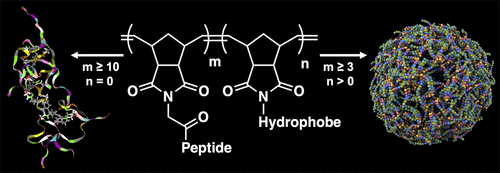当前位置:
X-MOL 学术
›
Acc. Chem. Res.
›
论文详情
Our official English website, www.x-mol.net, welcomes your feedback! (Note: you will need to create a separate account there.)
Poly(peptide): Synthesis, Structure, and Function of Peptide-Polymer Amphiphiles and Protein-like Polymers.
Accounts of Chemical Research ( IF 18.3 ) Pub Date : 2020-01-22 , DOI: 10.1021/acs.accounts.9b00518 Cassandra E Callmann 1, 2 , Matthew P Thompson 2 , Nathan C Gianneschi 1, 2
Accounts of Chemical Research ( IF 18.3 ) Pub Date : 2020-01-22 , DOI: 10.1021/acs.accounts.9b00518 Cassandra E Callmann 1, 2 , Matthew P Thompson 2 , Nathan C Gianneschi 1, 2
Affiliation

|
In this Account, we describe the organization of functional peptides as densely arrayed side chains on polymer scaffolds which we introduce as a new class of material called poly(peptide). We describe two general classes of poly(peptide): (1) Peptide-Polymer Amphiphiles (PPAs), which consist of block copolymers with a dense grouping of peptides arrayed as the side chains of the hydrophilic block and connected to a hydrophobic block that drives micelle assembly, and (2) Protein-like Polymers (PLPs), wherein peptide-brush polymers are composed from monomers, each containing a peptide side chain. Peptides organized in this manner imbue polymers or polymeric nanoparticles with a range of functional qualities inherent to their specific sequence. Therefore, polymers or nanoparticles otherwise lacking bioactivity or responsiveness to stimuli, once linked to a peptide of choice, can now bind proteins, enter cells and tissues, have controlled and switchable biodistribution patterns, and be enzyme substrates (e.g., for kinases, phosphatases, proteases). Indeed, where peptide substrates are incorporated, kinetically or thermodynamically driven morphological transitions can be enzymatically induced in the polymeric material. Synergistically, the polymer enforces changes in peptide activity and function by virtue of packing and constraining the peptide. The scaffold can protect peptides from proteolysis, change the pharmacokinetic profile of an intravenously injected peptide, increase the cellular uptake of an otherwise cell impermeable therapeutic peptide, or change peptide substrate activity entirely. Moreover, in addition to the sequence-controlled peptides (generated by solid phase synthesis), the polymer can carry its own sequence-dependent information, especially through living polymerization strategies allowing well-defined blocks and terminal labels (e.g., dyes, contrast agents, charged moieties). Hence, the two elements, peptide and polymer, cooperate to yield materials with unique function and properties quite apart from each alone. Herein, we describe the development of synthetic strategies for accessing these classes of biomolecule polymer conjugates. We discuss the utility of poly(peptide)-based materials in a range of biomedical applications, including imaging of diseased tissues (myocardial infarction and cancer), delivering small molecule drugs to tumors with high specificity, imparting cell permeability to otherwise impermeable peptides, protecting bioactive peptides from proteolysis in harsh conditions (e.g., stomach acid and whole blood), and transporting proteins into traditionally difficult-to-transfect cell types, including stem cells. Poly(peptide) materials offer new properties to both the constituent peptides and to the polymers, which can be tuned by the design of the oligopeptide sequence, degree of polymerization, peptide arrangement on the polymer backbone, and polymer backbone chemistry. These properties establish this approach as valuable for the development of peptides as medicines and materials in a range of settings.
中文翻译:

聚(肽):肽聚合物两亲物和类蛋白质聚合物的合成、结构和功能。
在这篇文章中,我们将功能性肽的组织描述为聚合物支架上密集排列的侧链,我们将其作为一类称为聚(肽)的新型材料引入。我们描述了两种一般类型的聚(肽):(1) 肽-聚合物两亲物 (PPA),它由嵌段共聚物和密集的肽组组成,这些肽排列成亲水性嵌段的侧链,并连接到疏水性嵌段,驱动胶束组装,以及 (2) 类蛋白质聚合物 (PLP),其中肽刷聚合物由单体组成,每个单体都包含一个肽侧链。以这种方式组织的肽使聚合物或聚合物纳米粒子具有其特定序列固有的一系列功能特性。因此,聚合物或纳米粒子在其他方面缺乏生物活性或对刺激的反应,一旦连接到所选的肽,现在可以结合蛋白质,进入细胞和组织,具有受控和可切换的生物分布模式,并且是酶底物(例如,激酶、磷酸酶、蛋白酶)。实际上,在掺入肽底物的情况下,可以在聚合材料中酶促诱导动力学或热力学驱动的形态转变。协同地,聚合物通过包装和约束肽来强制改变肽活性和功能。支架可以保护肽免于蛋白水解,改变静脉注射肽的药代动力学特征,增加细胞对其他细胞不可渗透的治疗肽的摄取,或完全改变肽底物活性。而且,除了序列控制的肽(由固相合成产生)外,聚合物还可以携带其自身的序列相关信息,特别是通过活性聚合策略允许定义明确的块和末端标记(例如,染料、造影剂、带电部分) ). 因此,这两种元素,肽和聚合物,共同产生具有独特功能和特性的材料,这些材料与单独使用的完全不同。在此,我们描述了用于获取这些类别的生物分子聚合物缀合物的合成策略的开发。我们讨论了基于聚(肽)的材料在一系列生物医学应用中的实用性,包括病变组织(心肌梗塞和癌症)的成像,以高特异性将小分子药物递送至肿瘤,赋予细胞渗透性以其他方式不可渗透的肽,保护生物活性肽在恶劣条件下(例如,胃酸和全血)免受蛋白水解,并将蛋白质转运到传统上难以转染的细胞类型,包括干细胞。聚(肽)材料为组成肽和聚合物提供了新的特性,这些特性可以通过寡肽序列的设计、聚合度、聚合物主链上的肽排列和聚合物主链化学进行调整。这些特性确立了这种方法对于在一系列环境中将肽开发为药物和材料的价值。聚(肽)材料为组成肽和聚合物提供了新的特性,这些特性可以通过寡肽序列的设计、聚合度、聚合物主链上的肽排列和聚合物主链化学进行调整。这些特性确立了这种方法对于在一系列环境中将肽开发为药物和材料的价值。聚(肽)材料为组成肽和聚合物提供了新的特性,这些特性可以通过寡肽序列的设计、聚合度、聚合物主链上的肽排列和聚合物主链化学进行调整。这些特性确立了这种方法对于在一系列环境中将肽开发为药物和材料的价值。
更新日期:2020-01-23
中文翻译:

聚(肽):肽聚合物两亲物和类蛋白质聚合物的合成、结构和功能。
在这篇文章中,我们将功能性肽的组织描述为聚合物支架上密集排列的侧链,我们将其作为一类称为聚(肽)的新型材料引入。我们描述了两种一般类型的聚(肽):(1) 肽-聚合物两亲物 (PPA),它由嵌段共聚物和密集的肽组组成,这些肽排列成亲水性嵌段的侧链,并连接到疏水性嵌段,驱动胶束组装,以及 (2) 类蛋白质聚合物 (PLP),其中肽刷聚合物由单体组成,每个单体都包含一个肽侧链。以这种方式组织的肽使聚合物或聚合物纳米粒子具有其特定序列固有的一系列功能特性。因此,聚合物或纳米粒子在其他方面缺乏生物活性或对刺激的反应,一旦连接到所选的肽,现在可以结合蛋白质,进入细胞和组织,具有受控和可切换的生物分布模式,并且是酶底物(例如,激酶、磷酸酶、蛋白酶)。实际上,在掺入肽底物的情况下,可以在聚合材料中酶促诱导动力学或热力学驱动的形态转变。协同地,聚合物通过包装和约束肽来强制改变肽活性和功能。支架可以保护肽免于蛋白水解,改变静脉注射肽的药代动力学特征,增加细胞对其他细胞不可渗透的治疗肽的摄取,或完全改变肽底物活性。而且,除了序列控制的肽(由固相合成产生)外,聚合物还可以携带其自身的序列相关信息,特别是通过活性聚合策略允许定义明确的块和末端标记(例如,染料、造影剂、带电部分) ). 因此,这两种元素,肽和聚合物,共同产生具有独特功能和特性的材料,这些材料与单独使用的完全不同。在此,我们描述了用于获取这些类别的生物分子聚合物缀合物的合成策略的开发。我们讨论了基于聚(肽)的材料在一系列生物医学应用中的实用性,包括病变组织(心肌梗塞和癌症)的成像,以高特异性将小分子药物递送至肿瘤,赋予细胞渗透性以其他方式不可渗透的肽,保护生物活性肽在恶劣条件下(例如,胃酸和全血)免受蛋白水解,并将蛋白质转运到传统上难以转染的细胞类型,包括干细胞。聚(肽)材料为组成肽和聚合物提供了新的特性,这些特性可以通过寡肽序列的设计、聚合度、聚合物主链上的肽排列和聚合物主链化学进行调整。这些特性确立了这种方法对于在一系列环境中将肽开发为药物和材料的价值。聚(肽)材料为组成肽和聚合物提供了新的特性,这些特性可以通过寡肽序列的设计、聚合度、聚合物主链上的肽排列和聚合物主链化学进行调整。这些特性确立了这种方法对于在一系列环境中将肽开发为药物和材料的价值。聚(肽)材料为组成肽和聚合物提供了新的特性,这些特性可以通过寡肽序列的设计、聚合度、聚合物主链上的肽排列和聚合物主链化学进行调整。这些特性确立了这种方法对于在一系列环境中将肽开发为药物和材料的价值。


























 京公网安备 11010802027423号
京公网安备 11010802027423号